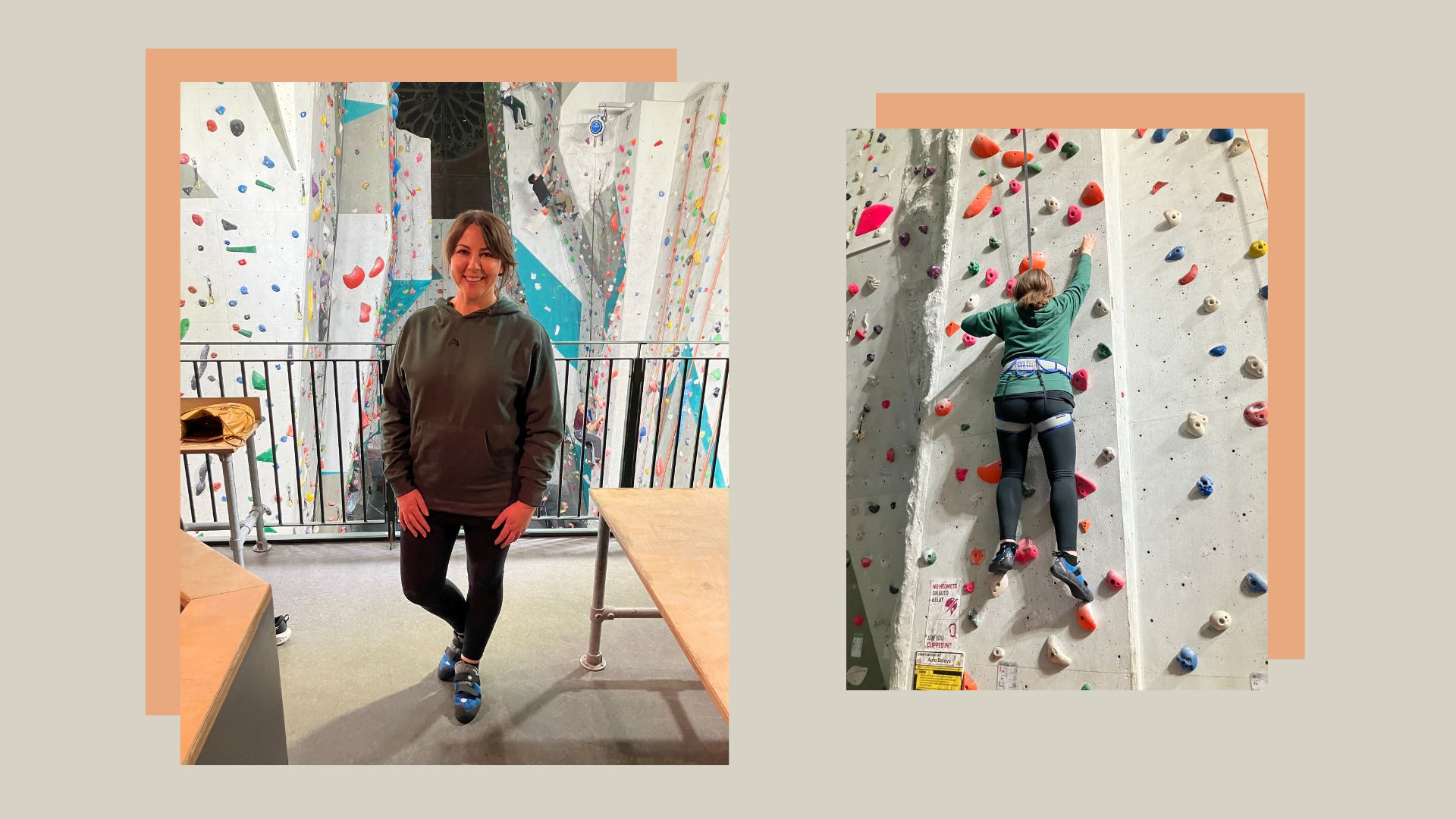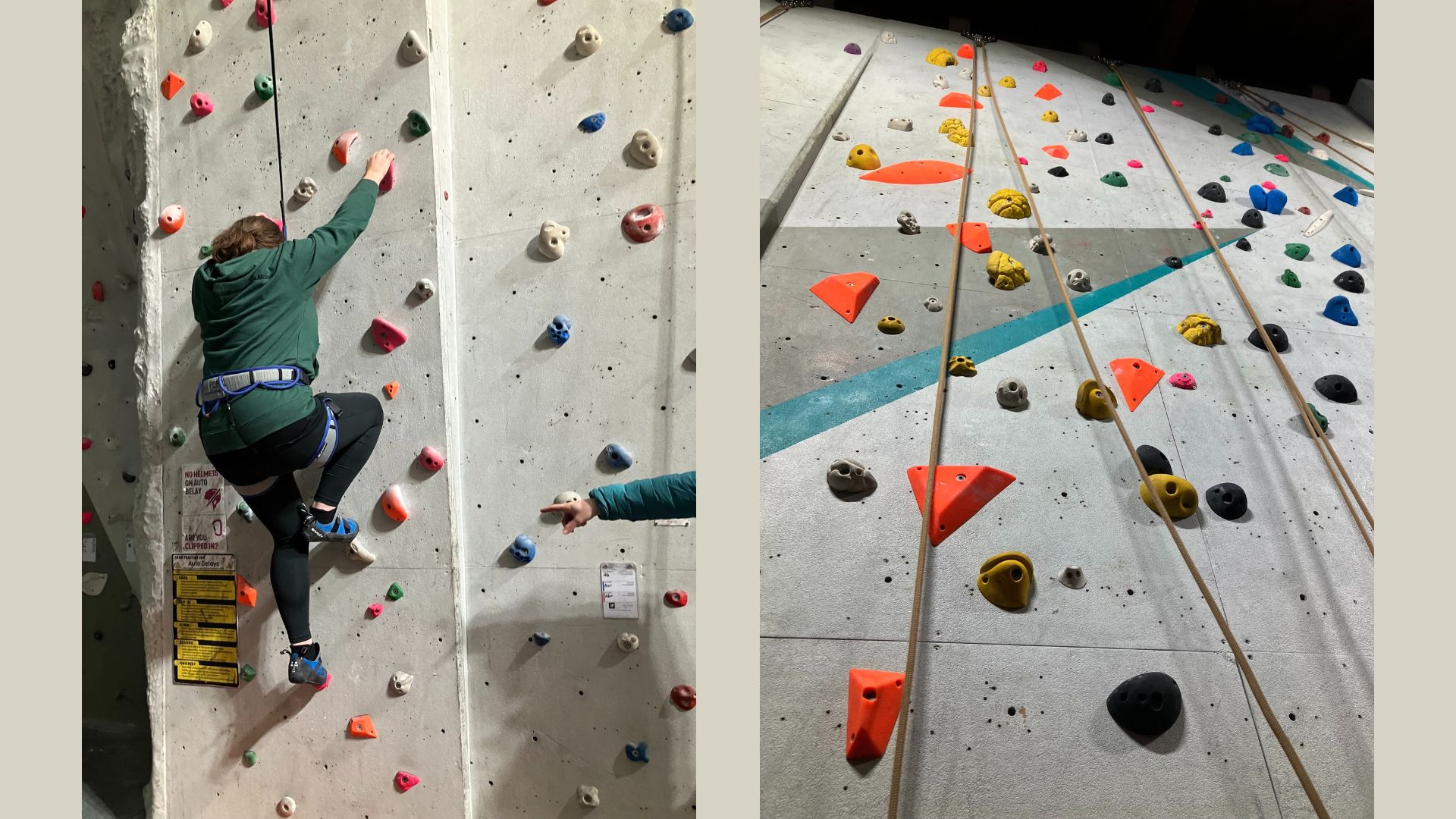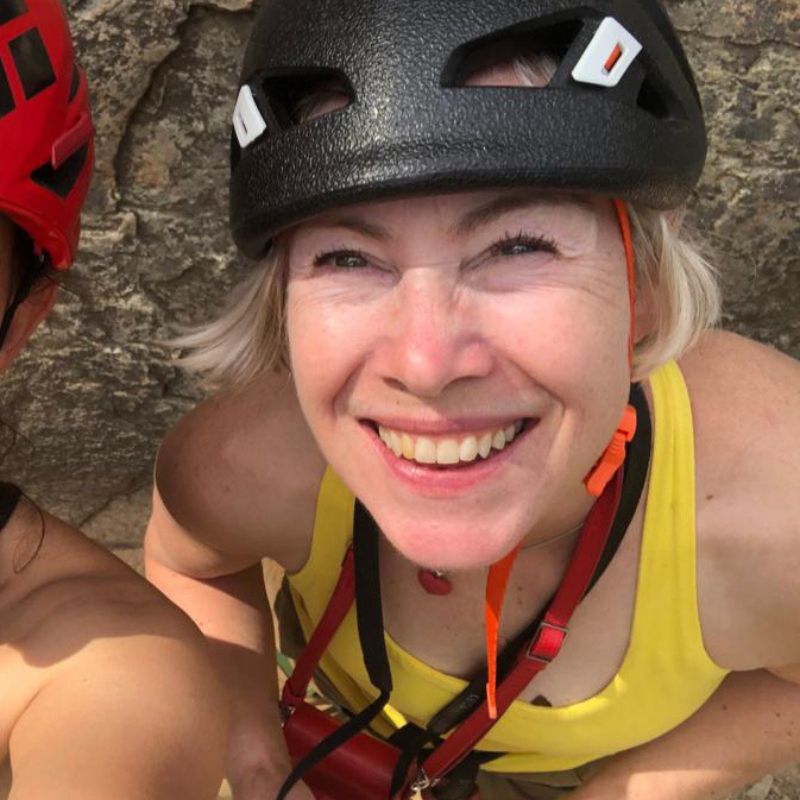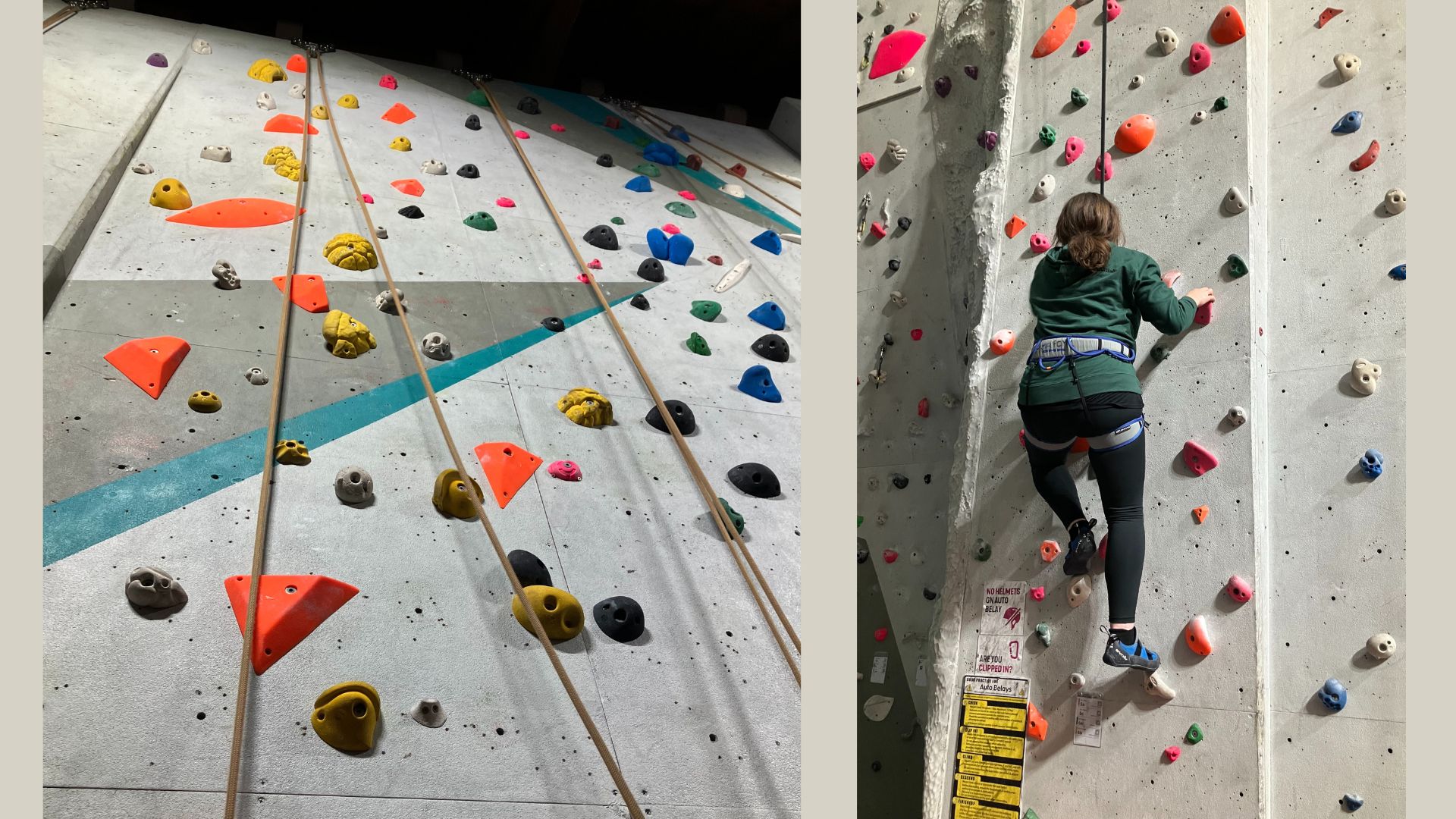I tried indoor climbing for beginners for the first time in my 40s - and here's how it went
There are plenty of benefits to be enjoyed from indoor climbing for beginners, if you are willing to face your fears and take that first step, says Susan Griffin


Ever found yourself in a situation and wondered how on earth you got there? It was a thought that occurred to me as I clung to an indoor climbing wall recently, muscles shaking with the strain and unable to move my arm to the next handhold.
I wasn't sure whether I'd mentally frozen or I was physically incapable, but either way, I came to a grinding halt. I was mid-way on the wall but might as well be at the top because I can’t just lower myself back down.
"Can I come down now, please," I squeak in the direction of the instructor below me.
My climbing buddy, overseen by the instructor, released the rope and I began my descent. Thankfully, it's not long before I am back on terra firma. I am exhausted, my hands are red, my arms feel numb, and there is still over an hour of the introductory session to go.
So, how exactly did I end up in this situation? I have only myself to blame. I've been on a personal mission over the last few years since turning 40 to shake off limiting beliefs that can creep up on you with age and to push myself out of my comfort zone. I've also been trying to increase my movement in lots of different ways too - from exploring the benefits of hiking to taking up badminton for beginners - as it's one of the best things you can do for your wellbeing and posture, especially as you get older. Indoor climbing for beginners sat on my list to do, so now seemed like a better time than any.
What is indoor climbing?
Indoor climbing is also known as rope climbing and it's what you probably think of when you hear the term 'rock climbing' in an indoor context. It requires you to be harnessed up and attached to a rope, controlled by someone standing at the bottom of the wall, as you climb.
Unlike bouldering, which is rope-free and contains as many parallel routes as it does upward routes, rope climbing requires you to move up the wall. The wall, in my case, stretched from the floor to the ceiling of a converted church near Manchester.
Sign up to our free daily email for the latest royal and entertainment news, interesting opinion, expert advice on styling and beauty trends, and no-nonsense guides to the health and wellness questions you want answered.
While rope climbing has been around for millennia, interest in the activity has peaked again in the last few years due to social media, as is often the case. The success of documentaries such as Free Solo and Dawn Wall has also helped newcomers of all ages explore the sport and see it as more accessible than before.
There are now over 500 walls in the USA and over 400 in the UK. The sport made its debut as a medal sport at the last Olympics in Tokyo, and outdoor festivals all over the UK have included indoor climbing for beginners in their offering - including the most recent Kendal Mountain Festival, where I was recently able to see how climbing worked close-up and see how inclusive it was with a wide range of ages and abilities.
I booked myself onto an Intro to Climbing session at Parthian Climbing on my return from the festival, determined to give the trending activity a go myself. Wearing a harness and a fetching pair of Velcro climbing shoes I hired from the venue, it was perhaps one of the more eye-opening ways I've spent an hour and a half.

What I learnt trying indoor climbing for beginners
1. You can't let nerves hinder you
One of the most common misconceptions about indoor climbing for beginners is that it is for ‘young’ people or it is only an extreme sport, but this is far from the truth. As someone who was hollering to be winched down on more than one occasion during my session, I can vouch for how inclusive and friendly it is. There was no pointing or sniggering. People are either too busy focusing on their climbs or appreciate how challenging it is, so they are more likely to cheer than sneer.
"I would say the climbing community is one of the strongest reasons to give it a go," agrees competitive climber and Red Bull athlete Shauna Coxsey. "Everyone is so welcoming and supportive in a way you don't get by just going to the gym, for example. There are climbing walls in most towns and in lots of walls in major cities so you are never far from a wall, and most will have amazing induction courses which help you take your first steps into the vertical world.” You can find a wall via websites such as Association of British Climbing Walls.

Shauna Coxsey is Britain’s most successful-ever competitive climber and the UK’s first-ever Bouldering World Champion. She is also a Red Bull athlete.
2. Climbing is a level playing field
Although men and women don’t compete against each other at the Olympics, gender parity is noteworthy within climbing - and women are among the best climbers in the world.
According to a study by Columbia University, this is likely due to evolutionary origin as the human body was shaped to climb well irrespective of sex.
“With climbing, balance and flexibility is more important than strength. This makes climbing more of a level playing field and women can excel in climbing, for sure,” says Susie Norris, a climbing instructor and coach at the Castle Climbing Centre in London.
As with gender, age isn’t a limitation in indoor climbing for beginners. "I work with a woman who is 65, and although she's completely out of her depth, she's so excited to climb. It's wonderful to be able to encourage her. A friend of mine is 71 and she is just phenomenal, unstoppable," she says.
A quick scan around the climbing centre revealed there were as many women as men, if not more, and in my group alone, three women to one man, which was encouraging to see.

Susie Norris is a climbing instructor and coach at the Castle Climbing Centre in London, teaching climbers how to build confidence and climb efficiently and effectively.
3. You need to be prepared to ache
It was probably within a few minutes of climbing that I realised I was going to ache the following day - and the day after. My back and arms seemed to take the brunt. This is partly because, against the instructor’s advice, I was using my arms to pull rather than my legs to push (no doubt technique comes with experience), but also because indoor climbing gets you moving in unique ways.
"Climbing is an all-body workout, but because it can be quite confronting as a beginner, the aching you feel is likely due to over-gripping, which exerts so much energy and before you know it your forearms feel like they’re falling off,” says Norris.
At the beginning of our session, we were running on the spot, doing star jumps, and easy cardio exercises to get the blood pumping, but as a novice, there is no doubt you are going to feel it. Especially if, like me, you haven’t done much strength training of late.
"Climbing requires you to move your weight upwards, usually. Your legs are generally stronger, so it’s useful to think about stepping up rather than pulling up. Doing yoga as a workout is the best compliment to climbing because it improves flexibility, balance, and (optimum) breathing, which is key," she says.

4. There are mental benefits to climbing
Although you can expect to burn anywhere between 500 and 800 calories an hour, making it on par with how many calories you burn swimming or running in some cases, indoor climbing is not just a physical workout.
"To climb well, you have to look where you are going, identify what technique you need, what the holds are going to be like, the body position you need to adopt and then apply yourself, which provides a mental challenge," says Norris. "The focus that’s needed also helps to put everything else in perspective, to calm you down, and to encourage you to live in the moment."
Even as someone doing indoor climbing for beginners, when you are not necessarily following any particular route, you are simply working out how to set off. When the footholds are so small, there is a lot to consider. It keeps your mind busy and in the moment, so you will find any stresses from the day have ebbed away by the end of your session.
5. Indoor climbing can give you confidence off the wall too
It is so easy to let your inner critic let you think you are too old to try something new or not fit or able enough. But it's just about taking that first step, literally, to keep going and not be deterred when it doesn’t go according to plan straight away.
“Climbing is a sport that demands mental toughness, physical strength, and emotional drive. Striving for balance can help climbers improve their skills and become better versions of themselves, both on and off the mountain,” says Alan Arnette, who began climbing at 38, summited Everest at 54 and now coaches climbers through his company Summit Coach. "Although it took me four attempts to reach the summit of Mt. Everest, each 'non-summit' was a valuable learning experience," he notes.
I was the only one during the introductory session who never got to the top of a wall, it didn’t matter as there was no sense of competition. And with each attempt, I got that bit further, which is a confidence boost in itself.
If you're looking to learn how to be more confident in general life, exercise is a useful tool and this could be the activity for you.

Alan Arnette is a climber from Colorado who summited Everest at 54 and K2 at 58, a US age record. He coaches climbers through Summit Coach, a consulting business where he advises aspiring climbers on how to reach their dreams.
Tips for indoor climbing
- Don’t be afraid to ask for help or guidance: "A lot of walls have amazing staff on hand to help you learn, and there are almost always other climbers ready to lend a hand," says Coxsey. I found this during my session - there is a sense of camaraderie from the get-go. You are also each other’s belayers when you climb with others and that is bonding in itself.
- Be realistic: "Be realistic about your capabilities and don’t climb in competition with anyone. Run your race," says Arnette.
- Do your research: Ahead of your climb, do some research on the basic techniques that you'll need on the wall.
- Enjoy yourself: "As adults, we lose that sense of play. [I suggest you] really learn to enjoy moving around on a wall," says Coxsey. I certainly did - when you do something out of your comfort zone, there is an urge to give up, but the benefits come when you get back on the wall and give it another go.
Another important tip: Make sure you wear something you can move freely in. Wear something you feel comfortable and confident in, I'd say. For example, a pair of workout leggings, a comfortable T-shirt, a jumper, and socks. You can feel vulnerable enough wearing a harness and want to be able to focus on the task at hand.
A journalist with two decades of experience, Susan interviewed A-list names in film and TV before going freelance and focusing on health, wellbeing, and lifestyle features. She has since spoken to world-renowned experts on the most innovative and effective ways to look after your mind and body; her work appearing in publications such as Daily Express, Daily Mirror, Metro, Fabulous and The Telegraph. When Susan isn’t working on her laptop, she is most content hiking in the Peak District or finding quiet camping spots to while away a weekend and knows first-hand the restorative benefits of being outdoors.
